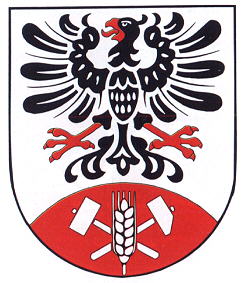Kamsdorf: Difference between revisions
Jump to navigation
Jump to search
Knorrepoes (talk | contribs) m (Text replacement - "/Arms of " to "/Arms (crest) of ") |
Knorrepoes (talk | contribs) m (Text replacement - "{{media}}" to " {{de1}} {{media1}}") |
||
| Line 25: | Line 25: | ||
The black eagle is the eagle of Preussen (Prussia), as the village historically belonged to Preussen. The red mountain in the base symbolises the local Rote Berg (red mountain). The wheatear and miner's tools are derived from the old seal of Grosskamsdorf and symbolise agriculture and mining. | The black eagle is the eagle of Preussen (Prussia), as the village historically belonged to Preussen. The red mountain in the base symbolises the local Rote Berg (red mountain). The wheatear and miner's tools are derived from the old seal of Grosskamsdorf and symbolise agriculture and mining. | ||
{{ | |||
{{de1}} | |||
{{media1}} | |||
[[Civic Heraldry Literature - Germany|'''Literature''']]: Ulle, 1997. | [[Civic Heraldry Literature - Germany|'''Literature''']]: Ulle, 1997. | ||
Revision as of 12:36, 26 December 2022
This page is part of the German heraldry portal |
Heraldry of the World |
|
German heraldry:
|
Selected collector's items from Germany:
|
KAMSDORF
State : Thüringen
District (Kreis) : Saalfeld-Rudolstadt
Incorporated into : 2018 Unterwellenborn
| German |
In Silber über einem mit einer silbernen Ähre mit gekreuztem Schlägel und Eisen belegten roten Berg schwebend ein rechtsgewendeter rot bewehrter schwarzer Adler. |
| English | No blazon/translation known. Please click here to send your (heraldic !) blazon or translation |
Origin/meaning
The arms were officially granted on January 4, 1993.
The black eagle is the eagle of Preussen (Prussia), as the village historically belonged to Preussen. The red mountain in the base symbolises the local Rote Berg (red mountain). The wheatear and miner's tools are derived from the old seal of Grosskamsdorf and symbolise agriculture and mining.
Literature: Ulle, 1997.


